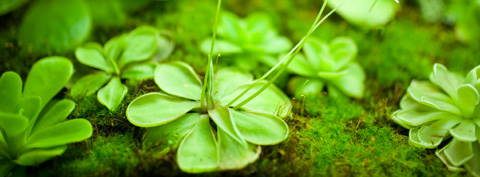Terrariums are a creative way to decorate your home using miniature landscapes that require little care. Because of their design possibilities and primordial mystique, terrariums are one of the hottest trends in indoor plants—even showing up as centerpieces for weddings and events.
 Terrariums can be traditional in style, ultra-modern, and everything in-between.
Terrariums can be traditional in style, ultra-modern, and everything in-between.
Terrariums are simply a collection of plants grown together in a clear container such as an aquarium, cloche, jar, or bottle. Sitting on a table, terrariums can transport you to a calm and tranquil state of mind with dappled light creating shadows among the foliage. Part of the infatuation with terrariums is that they don’t require a great deal of gardening know-how, making them perfect for people who love plants but hate taking care of them. Once established, the plants create their own climate and only need watering every few weeks. In fact, they can sometimes go months without needing any attention.
Open and Closed Terrariums
There are two types of terrariums—enclosed containers that have lids and open containers that do not. Inside a closed terrarium is a continuous rain cycle—moisture evaporates from the soil and plant leaves and condenses on the terrarium's roof and walls, drops down and re-moistens the soil.
The ideal plants for enclosed terrariums are those that prefer moist soil, a humid environment, and low to medium light. Classic terrarium basics include small ferns, bromeliads, pothos, dracaena, mosses, and baby’s tears. To add color, you can layer in miniature African violets, croton, prayer plants, or lipstick plants. For a full lush appearance, include ivy, creeping Charlie, and creeping fig.
 African violets add a burst of color to the landscape.
African violets add a burst of color to the landscape.
Open terrariums require more frequent watering since the moisture escapes into the air, but they’re still extremely low maintenance. Look for plants that need less moisture and thrive in low to medium light—like philodendron, piggy-back plant, and sweet olive. If you want to add color and texture include earth stars, fittonia, and begonias. For filler plants, consider peperomia and ivy. With an open terrarium you can also try plants that won’t work in the most environment of a closed terrarium—try succulents and cacti, for example, for a desert theme.
Design Your Own
Creating your own terrarium is actually very simple—it just requires a glass container, gravel, soil, and plants. Start with one to three inches of pea gravel, pebbles, or very coarse sand spread evenly across the bottom of the terrarium. This will ensure proper drainage so that the soil stays moist, but not wet. Next add a thin layer of activated charcoal, used in aquariums to filter the water and keep it clean. On top of this add a layer of sphagnum moss to prevent the soil from sifting to the bottom and getting into the pebble layer. Finally, add potting mix deep enough to cover the roots of the plants you select.
 Moss creates a lush, green carpet in a terrarium.
Moss creates a lush, green carpet in a terrarium.
When choosing plants for your terrarium, select a mixture of sizes, leaf textures, and leaf colors for a natural look. Be sure the plants are small enough to fit inside the terrarium without touching the sides. A good rule of thumb is to plant in odd numbers and to arrange the plants while still in their pots, before planting, to be sure to get the look you desire. Once positioned, simply remove the plants from the pots and place them in the soil. Then add decorative elements like stones, wood, or any object that strikes your fancy—perhaps figurines, shells, or artificial butterflies.
Maintenance
Terrariums thrive on neglect. Since you want to keep the plants diminutive and slow growing, you don’t need to fertilize. And since they’re constantly recycling water, they’ll thrive for years with very little attention.
 Combine plants with coordinating colors and textures to add interest.
Combine plants with coordinating colors and textures to add interest.
But, it’s still important to keep an eye on the amount of water in your terrarium, and to remember that it’s always better to have too little water than too much. As long as you see small drops of condensation on the glass, there’s no need to water. If large water drops appear on the glass, you may be over watering. This is easily remedied by slightly opening the lid to allow for air circulation and evaporation. If there is no condensation, you’ll need to add water, but do so sparingly, since over watering can lead to mold. So easy does it, you can always add more water the next day, if needed.
Occasionally, it may be necessary to replace a plant that has outgrown the container or to prune or replace a dead plant. Other than this, your terrarium should thrive with no maintenance needed.
















